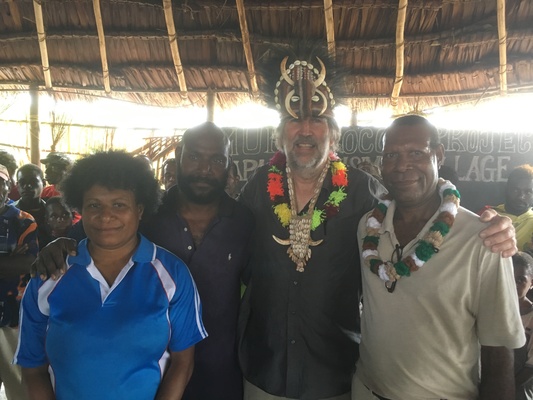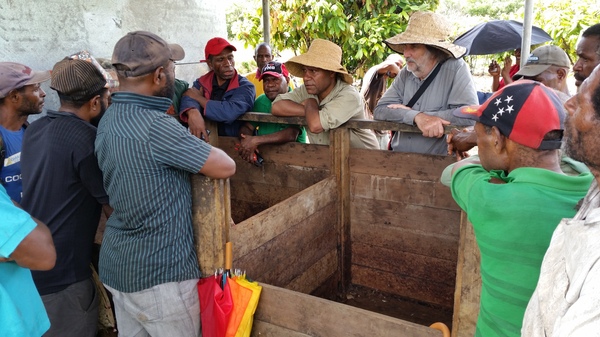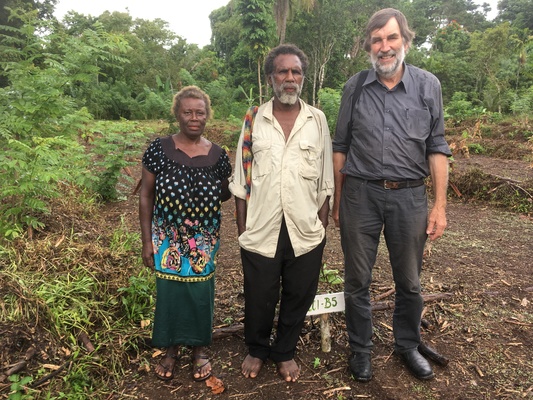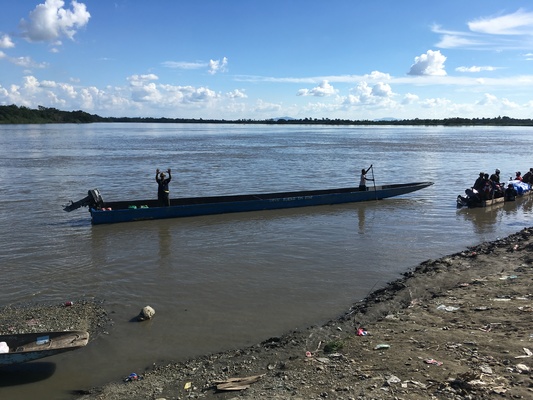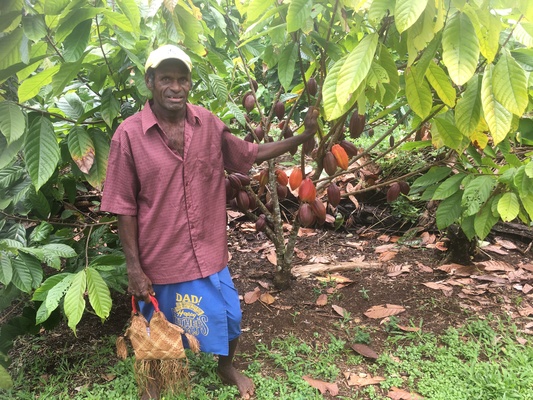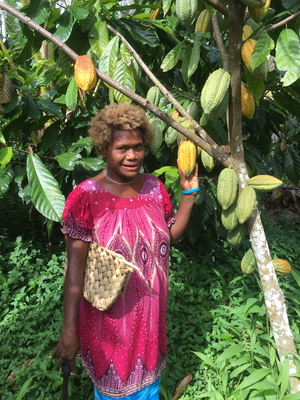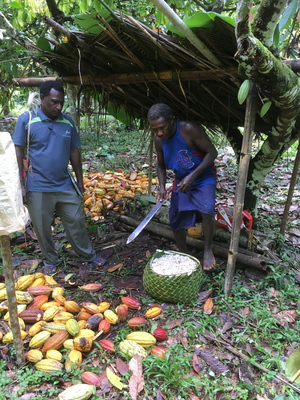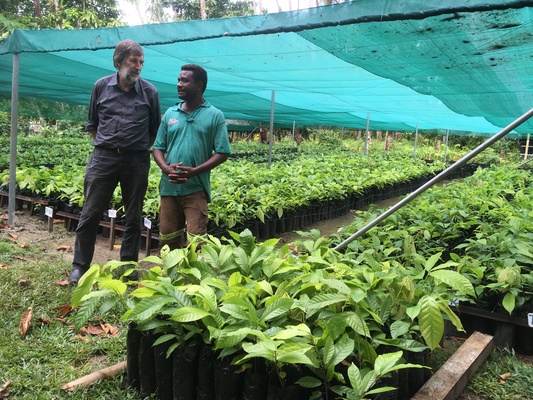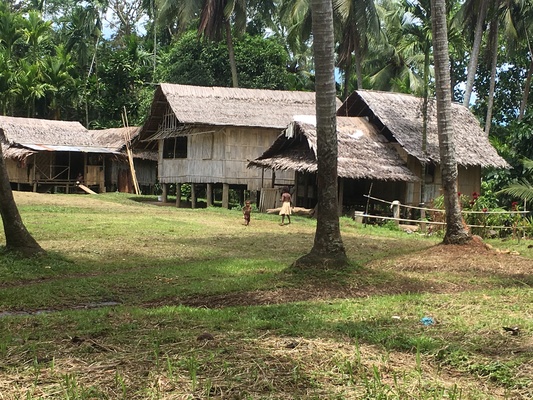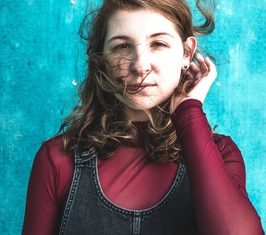Words: Elissa Friday
Mmm, chocolate. ELISSA FRIDAY meets a Geelong man helping our near-neighbours make a living from some of the world’s mostly highly prized cocoa beans.
With demand for chocolate steadily increasing globally, consuming it has become almost second nature for many.
Abundant commercial supplies of cocoa feed the hunger, helping chocolate rival coffee as a favourite indulgence.
And a Geelong researcher is helping feed the demand with his work on cocoa crops in Australia’s nearest northern neighbour, which delivers some of the world’s most highly regarded chocolate.
“Papa New Guinea is known for producing high-flavour cocoa used for speciality chocolate, Dr Philip Keane says.
“But cocoa originated in the Americas, in the Amazon, and was first domesticated by the Mayan people.”
Dr Keane explains that cocoa arrived in Papua New Guinea in the late 1800s when Germany had a colony in the New Britain islands
“It was the Germans who introduced cocoa to PNG, which is the high-flavour type being produced today.”
Dr Keane spends much of his time in Papua New Guinea leading a $5 million, five-year project, funded by the Department of Foreign Affairs and Trade.
The project, titled Enterprise-driven Transformation of Family Cocoa Production in the East Sepik, Madang, New Ireland and Chimbu Provinces of Papua New Guinea, is all about saving the industry in Papua New Guinea.
Dr Keane says cocoa can be a profitable crop for owners of small landholdings in Papua New Guinea, providing the country with an export commodity and an important driver of rural development.
“The project is intensive training for management of the crop,” he explains.
“The whole family can be involved in it, including women.”
Dr Keane traces his interest in agriculture back to his grandfather, who was a farmer near Port Fairy.
“I was always interested in agriculture and probably would have been a farmer if my father had of been one,” he says.
A native of South Australia, Dr Keane studied at University of Adelaide’s Waite Agricultural Research Institute, completing a Bachelor of Agricultural Science with Honours in 1968 and specialising in plant pathology and fungi.
In 1969 he enrolled as a PhD student at the University of Papua New Guinea. Three years later he completed a doctorate in studies of oncobasidium theobromae, a disease causing dieback in cocoa plants.
“A lot of the cocoa in Papua New Guinea had been badly damaged by it,” Dr Keane remembers.
“About 90 per cent of the cocoa was killed by an epidemic and about 10 per cent of trees had a genetic resistance and survived”.
Dr Keane studied the disease on a scholarship from a cocoa growers’ association, basing himself in a lowlands experiment station.
“During my PhD I did find the cause of the disease, which we called vascular streak die-back. The cause was a fungus that grew in the plant’s conducting tissue or branches, which blocked the plant’s intake of water.
“It was extremely useful to know the cause of the disease and how it spread via spores that blew in the wind then infected the trees while they were growing.”
The solution was relatively straight forward, Dr Keane explains.
“Infected cocoa pods would be cut off and buried”.
Eventually resistant trees were identified and provided to local farmers, with the supply now extending to nearby nations in South East Asia with their own cocoa dieback issues.
“It’s an evolutionary story,” Dr Keane says.
After completing his PhD Dr Keane secured a job lecturing in biology and agriculture at the University of Papa New Guinea. He and wife Tihomila, “a Croatian migrant who came to Geelong just after the war in 1950”, spent the first six years of their married life in the country, during which time they also welcomed the birth of a daughter.
The family left Papua New Guinea later in 1974, with Dr Keane eventually finding work as an associate professor at La Trobe University.
After he led a further three projects on cocoa development in Indonesia and Papua New Guinea, between 2001 and 2015.
Dr Keane returned to Geelong in 2007 with plans of retiring.
“I was still working at La Trobe and the train commuting turned out to be a dream for marking papers and doing computer work while travelling.”
Dr Keane retired from lecturing in 2015 but returned to the university as a research fellow, leading to his latest Papua New Guinea posting, which began in 2016 with a funding injection from Australian Foreign Affairs Minister Julie Bishop.
Dr Keane’s project is one of five with the Australian backing, the others including work on helping women find jobs in agriculture and commercialising sweet potato and the galip nut.
Dr Keane acknowledges that cocoa farming has a reputation for providing a meagre living for some communities overseas.
“Cocoa has got a bit of bad publicity, mainly in the Ivory Coast, where things are not controlled, in truth,” Philip says.
“It’s a low-input, low-production crop. It’s often grown by small-holder farmers who are also often very poor and the profits are made by middlemen.
“The farmers will have another job because they’re not paid enough to grow the crops well, which is the problem in global production. The farmers can’t afford to spend a lot of time on their crop, so they can’t afford to give it the attention it requires.
“Cocoa is still a colonial enterprise, in a sense.”
Dr Keane’s project aims to improve farmers’ livelihood through enhanced yields while also increasing productivity on existing farms to avoid the need for clearing rainforest.
“With the new demand for coconut products, such as palm oil, we’re encouraging a double crop of cocoa growing under the coconut trees on existing plantations,” he says.
However, Dr Keane believes that Papua New Guinean cocoa farmers also get a relatively raw deal on their product.
“The chocolate industry could certainly pay farmers more,” he says.
“Chocolatiers go to other places, like Vanuatu, and pay the farmers’ fairer for their chocolate.”
While his work might seem daunting enough, the tropical climate of Papua New Guinea presents its own challenges
“I’m weary of malaria,” Dr Keane says.
“It’s become resistant to malaria tablets. My wife got malaria a couple of times.
“Gastro’s also a concern.”
Then there’s the heat and humidity, usually 31C and 80 to 90 per cent respectively each day.
“A lot of people wouldn’t enjoy it but I put up with being hot and sweaty. I’m not naturally adapted to the wet tropics, like cocoa is,” Dr Keane laughs.


